一般现在时,现在进行时,一般将来时
(完整版)一般现在时、一般过去时、一般将来时、现在进行时

初中语法一般现在时、一般过去时、一般将来时、现在进行时四种时态的区别名称定义时间动词形式时间词always、sometimes、usually、1、动词原形often、every表示经常性或习2、第三人称单一般现在时平时、经常惯性的动作数morning、动词后-s/esevery week、twice a week等等now、rightnow、表示此时此刻或at theam/is/are+动词现在进行时现阶段正在进行正在进行ingmoment、的动作look、listen等in the future、1、will/shall+动next词原形表示将来发生的week/month、一般将来时即将、计划2、am/is/are事tomorrow、+going to+动词in two weeks原形等等ago、yesterday、表示过去某一时1、V-ed(规则last week/候或某一段时间过去(与现动词)一般过去时night、所发生的事情或在无关的)2、不规则动词just now、存在的状态变化once upon atime等注意:1、一般现在时——第三人称单数的动词变化规则:1)大多数动词在词尾加“S”如:stop-______; make-______read-______; play-______2)以辅音字母加“y”结尾的,要先将“y”变为“i”,然后在加“es”如:fly-______;carry-______study-______; worry-______3)以“s, x, ch, sh”结尾的,在词尾加“es”如:teach-______;watch-______4)以“o”结尾的动词,加“es”如:go-______do-______2、现在进行时——动词ing形式的变化规则1.一般动词直接在词尾+ing例:read→______(读)talk→______(交谈)sing→______(唱歌)2.以不发音e结尾的动词,先去e再加ing例:like→______喜欢write→______写skate→______(滑冰)3.以重读闭音节结尾且末尾只有一个辅音字母的动词,双写末尾字母,再加ing例:stop→______(停止)get→______(得到)4.少数几个以ie结尾的动词,变ie为f再加ing。
英语学习中常见的几种时态介绍

英语学习中常见的几种时态介绍中,常见的有一般现在时、现在进行时、一般将来时、一般过去时、过去进行时、现在完成时和一般过去将来时等时态,是我们在学习过程中必须掌握的。
掌握好这几种时态,对于学习英语的同学是大有益处的,在变换句式时经常要运用。
现我把学习过程中经常遇见的13种时态整理如下,供学习参考:一、一般现在时(The Indefinite Present Tense).一般现在时表示经常性的或习惯性的动作、特征或状态。
常见的一般现在时主要有以下三种句式:1.肯定句式。
一般现在时肯定句式主要由动词原形表示,第三人称单数的谓语动词后要加词尾-s或-es。
动词be根据主语不同的人称有不同的形式,第一人称单数中动词be用am,第一人称复数、第二人称单数和复数以及第三人称复数中动词be用are的形式,第三人称单数中动词be用is,动词have在主语是第三人称单数中变为has,其余情况均用原形have。
如:She is a worker.They are worker.He has a bike.We have a bike.I am the king of the world.2.疑问句式。
一般现在时变为疑问句时,一般在句首加助动词do或does的方式构成,第三人称单数时用does,其余情况都用do,主要动词一概不变,用原形;在以have或has为主要动词的句子中,可以直接将动词have或has提前放于句首,也可以在句首加动词do或does构成,have或has一律用原形have。
如:Do you work?Does he work?Has she a cake?Does she have a cake?其简略回答形式用“Yes+主语+动词”或“No+主语+动词+not”。
如:Yes, I do.No, he does not.Yes, she hasNo, she has not.3.否定句式。
一般现在时的否定句式在动词前加do/does not的形式构成。
一般现在时、现在进行时、一般将来时、一般过去时四大时态讲解表格对比总结
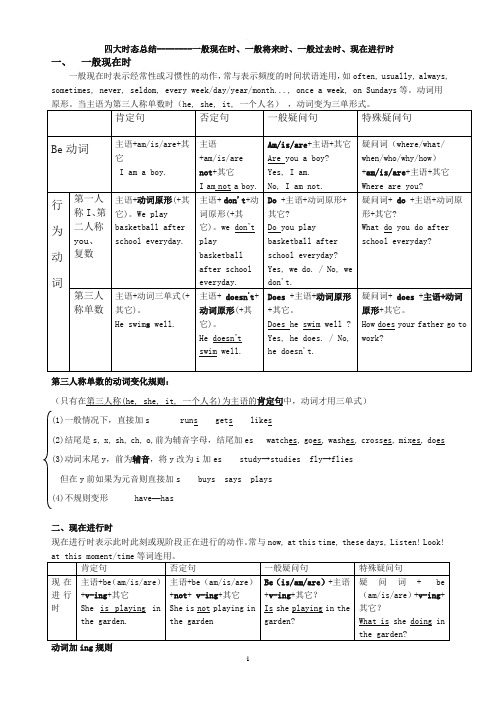
四大时态总结--------一般现在时、一般将来时、一般过去时、现在进行时一、一般现在时一般现在时表示经常性或习惯性的动作,常与表示频度的时间状语连用,如often, usually, always, sometimes, never, seldom, every week/day/year/month..., once a week, on Sundays等。
动词用第三人称单数的动词变化规则:(只有在第三人称(he, she, it, 一个人名)为主语的肯定句中,动词才用三单式)(1)一般情况下,直接加s runs gets likes(2)结尾是s, x, sh, ch, o,前为辅音字母,结尾加es watches, goes, washes, crosses, mixes, does(3)动词末尾y,前为辅音,将y改为i加es study→studies fly→flies但在y前如果为元音则直接加s buys says plays(4)不规则变形 have—has二、现在进行时现在进行时表示此时此刻或现阶段正在进行的动作。
常与now, at this time, these days, Listen! Look!动词加ing规则(1)直接在动词后加ing. going, starting, working.(2)去掉词尾不发音的e,再加ing. leave--leaving, make---making.注意:如果单词结尾的e发音,则不能去掉,也直接加ing. see –seeing agree - agreeing .(3) 对于动词只有一个元音,而其后跟了一个辅音字母时,双写末尾辅音字母再加ing.sitting, beginning run –running stop –stopping cut –cutting control –controlling(4)以ie结尾,把ie变y再加ing。
一般现在时,一般过去时,一般将来时及现在进行时
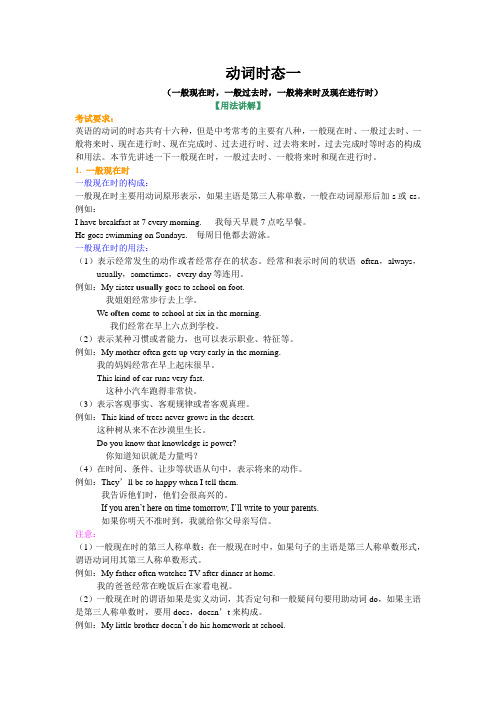
动词时态一(一般现在时,一般过去时,一般将来时及现在进行时)【用法讲解】考试要求:英语的动词的时态共有十六种,但是中考常考的主要有八种,一般现在时、一般过去时、一般将来时、现在进行时、现在完成时、过去进行时、过去将来时,过去完成时等时态的构成和用法。
本节先讲述一下一般现在时,一般过去时、一般将来时和现在进行时。
1. 一般现在时一般现在时的构成:一般现在时主要用动词原形表示,如果主语是第三人称单数,一般在动词原形后加-s或-es。
例如:I have breakfast at 7 every morning. 我每天早晨7点吃早餐。
He goes swimming on Sundays. 每周日他都去游泳。
一般现在时的用法:(1)表示经常发生的动作或者经常存在的状态。
经常和表示时间的状语often,always,usually,sometimes,every day等连用。
例如:My sister usually goes to school on foot.我姐姐经常步行去上学。
We often come to school at six in the morning.我们经常在早上六点到学校。
(2)表示某种习惯或者能力,也可以表示职业、特征等。
例如:My mother often gets up very early in the morning.我的妈妈经常在早上起床很早。
This kind of car runs very fast.这种小汽车跑得非常快。
(3)表示客观事实、客观规律或者客观真理。
例如:This kind of trees never grows in the desert.这种树从来不在沙漠里生长。
Do you know that knowledge is power?你知道知识就是力量吗?(4)在时间、条件、让步等状语从句中,表示将来的动作。
例如:They’ll be so happy when I tell them.我告诉他们时,他们会很高兴的。
英语最基本的五个时态
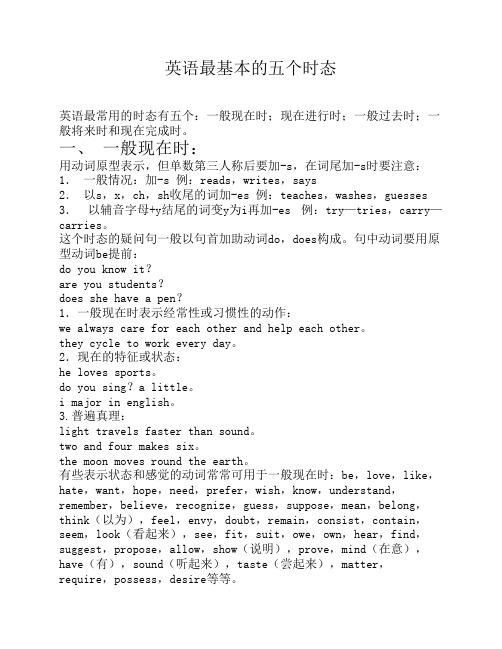
英语最基本的五个时态英语最常用的时态有五个:一般现在时;现在进行时;一般过去时;一般将来时和现在完成时。
一、 一般现在时:用动词原型表示,但单数第三人称后要加-s,在词尾加-s时要注意:1. 一般情况:加-s 例:reads,writes,says2. 以s,x,ch,sh收尾的词加-es 例:teaches,washes,guesses 3. 以辅音字母+y结尾的词变y为i再加-es 例:try—tries,carry—carries。
这个时态的疑问句一般以句首加助动词do,does构成。
句中动词要用原型动词be提前:do you know it?are you students?does she have a pen?1.一般现在时表示经常性或习惯性的动作:we always care for each other and help each other。
they cycle to work every day。
2.现在的特征或状态:he loves sports。
do you sing?a little。
i major in english。
3.普遍真理:light travels faster than sound。
two and four makes six。
the moon moves round the earth。
有些表示状态和感觉的动词常常可用于一般现在时:be,love,like,hate,want,hope,need,prefer,wish,know,understand,remember,believe,recognize,guess,suppose,mean,belong,think(以为),feel,envy,doubt,remain,consist,contain,seem,look(看起来),see,fit,suit,owe,own,hear,find,suggest,propose,allow,show(说明),prove,mind(在意),have(有),sound(听起来),taste(尝起来),matter,require,possess,desire等等。
一般现在时,现在进行时,一般将来时
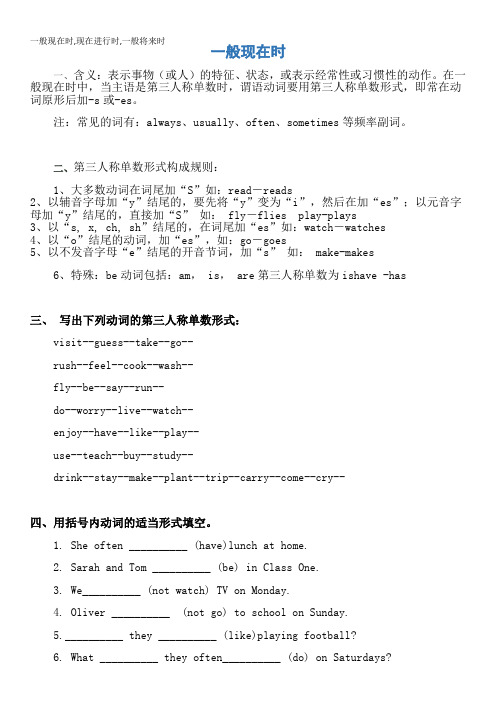
一般现在时,现在进行时,一般将来时一般现在时一、含义:表示事物(或人)的特征、状态,或表示经常性或习惯性的动作。
在一般现在时中,当主语是第三人称单数时,谓语动词要用第三人称单数形式,即常在动词原形后加-s或-es。
注:常见的词有:always、usually、often、sometimes等频率副词。
二、第三人称单数形式构成规则:1、大多数动词在词尾加“S”如:read-reads2、以辅音字母加“y”结尾的,要先将“y”变为“i”,然后在加“es”;以元音字母加“y”结尾的,直接加“S” 如: fly-flies play-plays3、以“s, x, ch, sh”结尾的,在词尾加“es”如:watch-watches4、以“o”结尾的动词,加“es”,如:go-goes5、以不发音字母“e”结尾的开音节词,加“s” 如: make-makes6、特殊:be动词包括:am, is, are第三人称单数为ishave -has三、写出下列动词的第三人称单数形式:visit--guess--take--go--rush--feel--cook--wash--fly--be--say--run--do--worry--live--watch--enjoy--have--like--play--use--teach--buy--study--drink--stay--make--plant--trip--carry--come--cry--四、用括号内动词的适当形式填空。
1. She often __________ (have)lunch at home.2. Sarah and Tom __________ (be) in Class One.3. We__________ (not watch) TV on Monday.4. Oliver __________ (not go) to school on Sunday.5.__________ they __________ (like)playing football?6. What __________ they often__________ (do) on Saturdays?7. __________ your parents __________ (read) newspapers?8. The girl__________ (teach) us English on Sundays.9. She and I __________ (take) a walk together every evening.10. There __________ (be) some water in the bottle.11. Mike__________ (like) cooking.12. He__________ (have) two new books.13. My sister __________ (look) after her baby carefully.14. You always __________ (do) your homework well.15. I__________ (be) ill. I’m staying in bed.16. She __________ (go) to school from Monday to Friday.17. Liu Tao __________ (do) not like PE.18. The child often __________ (watch) TV in the evening.19. -What day __________(be) it today?-It’s Saturday20.-How__________Dad __________(feel)?-He __________(feel) not well.21.-Where__________ he __________(work)?-He __________(work) at sea.现在进行时一、含义:表示正在做某事。
一般现在时-现在进行时-一般将来时

1一般现在时( Present Simple)2。
现在进行时(Present Continuous)3. 将来的安排和打算( Future Arrangements and Intentions)一、一般现在时、现在进行时(一)、辨”个性”一般现在时表示经常性或习惯性的动作,以及主语的特征或状态。
1。
表示主语现在的状态或特征。
例如:I am a teacher.We have a very good relationship with our parents.2。
表示经常性或习惯性动作。
例如:My father goes to work by bike every day。
I always leave home for school at 6:303 。
表示自然现象,普遍真理,客观存在或科学事实。
例如:Shanghai lies in the east of China.The earth moves around the sun.现在进行时表示现在或现阶段正在进行的动作。
例如:1。
表示现在(指说话人说话时)正在发生的事情We are waiting for you at the moment。
2. 表示现阶段正在进行或发生的动作President Xi is visiting in the USA these days。
(二)、辨结构一般现在时的结构是:主 + 动词原形或动词的第三人称单数形式 +...。
.。
现在进行时的结构是: 主 + be(are/ is/am),动词的—ing形式+.。
...。
(三)、辨”信息词"一般现在时常和以下这些时间状语连用:always, often, usually=normally, sometimes=at times, regularly, seldom, never, hardly ever, from time to time, once a month, every day, on Sundays。
如何区分一般现在时
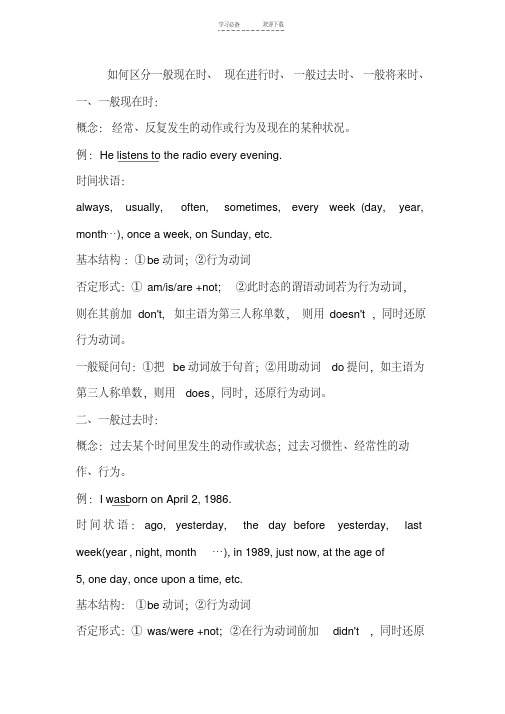
如何区分一般现在时、现在进行时、一般过去时、一般将来时、一、一般现在时:概念:经常、反复发生的动作或行为及现在的某种状况。
例:He listens to the radio every evening.时间状语:always, usually, often, sometimes, every week (day, year, month…), once a week, on Sunday, etc.基本结构:①be动词;②行为动词否定形式:①am/is/are +not;②此时态的谓语动词若为行为动词,则在其前加don't,如主语为第三人称单数,则用doesn't,同时还原行为动词。
一般疑问句:①把be动词放于句首;②用助动词do提问,如主语为第三人称单数,则用does,同时,还原行为动词。
二、一般过去时:概念:过去某个时间里发生的动作或状态;过去习惯性、经常性的动作、行为。
例:I wasborn on April 2, 1986.时间状语:ago, yesterday, the day before yesterday, last week(year, night, month…), in 1989, just now, at the age of5, one day, once upon a time, etc.基本结构:①be动词;②行为动词否定形式:①was/were +not;②在行为动词前加didn't,同时还原行为动词。
一般疑问句:①was或were放于句首;②用助动词do的过去式did 提问,同时还原行为动词。
三、现在进行时:概念:表示现阶段或说话时正在进行的动作及行为。
时间状语:at the monment look listen\now例:The woman is talking to the doctor.时间状语:now, at this time, these days, etc.基本结构:am /is/are +doing否定形式:am /is/are +not +doing.一般疑问句:把be动词放于句首。
五种时态一般现在时的_一般过去式_现在进行_现在完成时_一般将来时
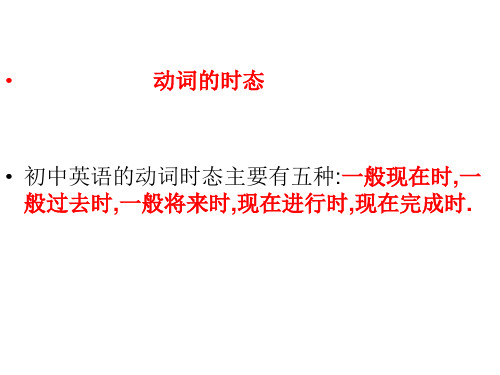
• • • • • • • • • • • • • • • • • • • • • • • • • • •
( ) 19. The day after tomorrow they ________ a volleyball match. A. will watching B. watches C. is watching D. is going to watch ( ) 20. There ________ a birthday party this Sunday. A. shall be B. will be C. shall going to be D. will going to be ( ) 21. They ________ an English evening next Sunday. A. are having B. are going to have C. will having D. is going to have ( ) 22. ________ you ________ free next Sunday? A. Will; are B. Will; be C. Do; be D. Are; be ( ) 23. He ________ there at ten tomorrow morning. A. will B. is C. will be D. be ( ) 24. ________ your brother ________ a magazine from the library? A. Are; going to borrow B. Is; going to borrow C. Will; borrows D. Are; going to borrows ( ) 25. – Shall I come again tomorrow afternoon? –________ (好的). A. Yes, please B. Yes, you will. C. No, please. D. No, you won’t. ( ) 26. It ________ the year of the horse next year. A. is going to be B. is going to C. will be D. will is ( ) 27. ________ open the window? A. Will you please B. Please will you C. You please D. Do you
一般现在时、现在进行时、一般将来时、一般过去时知识点总结
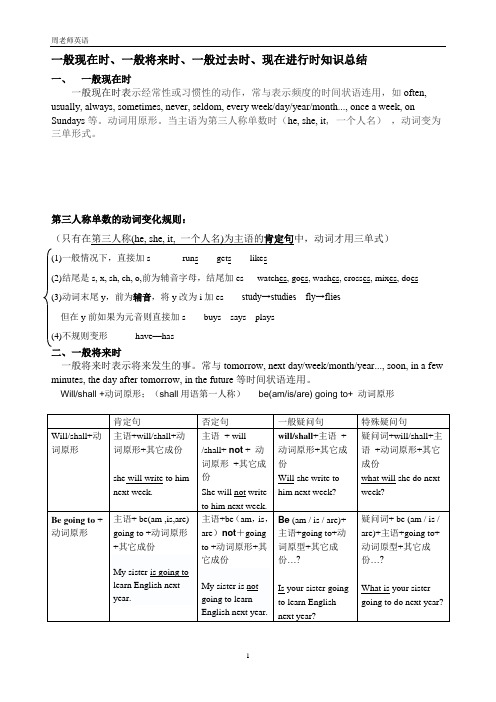
一般现在时、一般将来时、一般过去时、现在进行时知识总结一、一般现在时一般现在时表示经常性或习惯性的动作,常与表示频度的时间状语连用,如often, usually, always, sometimes, never, seldom, every week/day/year/month..., once a week, on Sundays等。
动词用原形。
当主语为第三人称单数时(he, she, it, 一个人名),动词变为三单形式。
第三人称单数的动词变化规则:(只有在第三人称(he, she, it, 一个人名)为主语的肯定句中,动词才用三单式)(1)一般情况下,直接加s runs gets likes(2)结尾是s, x, sh, ch, o,前为辅音字母,结尾加es watches, goes, washes, crosses, mixes, does(3)动词末尾y,前为辅音,将y改为i加es study→studies fly→flies但在y前如果为元音则直接加s buys says plays(4)不规则变形have—has二、一般将来时一般将来时表示将来发生的事。
常与tomorrow, next day/week/month/year..., soon, in a few minutes, the day after tomorrow, in the future等时间状语连用。
Will/shall +动词原形;(shall用语第一人称)be(am/is/are) going to+ 动词原形三、一般过去时一般过去时表示过去某一时候或某一段时间所发生了的事情或存在的状态。
常与过去时间yesterday,ago, this morning,just now,a moment ago,last night / year / week/month,once upon a time,the other day,before,the day before yesterday, in 1989, at the age of five, one day, then(那时), on that day,in the past连用。
一般现在时,现在进行时, 一般将来时
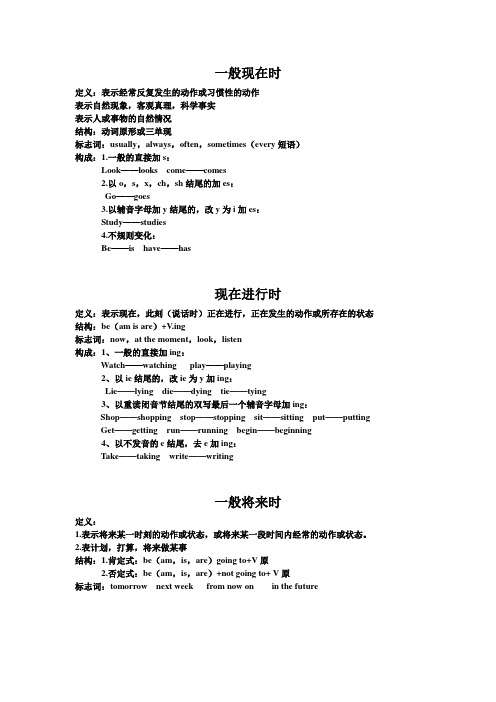
一般现在时定义:表示经常反复发生的动作或习惯性的动作表示自然现象,客观真理,科学事实表示人或事物的自然情况结构:动词原形或三单现标志词:usually,always,often,sometimes(every短语)构成:1.一般的直接加s:Look——looks come——comes2.以o,s,x,ch,sh结尾的加es:Go——goes3.以辅音字母加y结尾的,改y为i加es:Study——studies4.不规则变化:Be——is have——has现在进行时定义:表示现在,此刻(说话时)正在进行,正在发生的动作或所存在的状态结构:be(am is are)+V.ing标志词:now,at the moment,look,listen构成:1、一般的直接加ing:Watch——watching play——playing2、以ie结尾的,改ie为y加ing:Lie——lying die——dying tie——tying3、以重读闭音节结尾的双写最后一个辅音字母加ing:Shop——shopping stop——stopping sit——sitting put——putting Get——getting run——running begin——beginning4、以不发音的e结尾,去e加ing:Take——taking write——writing一般将来时定义:1.表示将来某一时刻的动作或状态,或将来某一段时间内经常的动作或状态。
2.表计划,打算,将来做某事结构:1.肯定式:be(am,is,are)going to+V原2.否定式:be(am,is,are)+not going to+ V原标志词:tomorrow next week from now on in the future。
小学英语四大时态语法知识点

小学英语四大时态语法知识点小学英语主要是如下的四大时态:一般现在时、现在进行时、一般过去时、一般将来时。
01一般现在时一、标志词always(总是)usually(通常)often(经常)sometimes(有时)never(从不)every(每一)二、基本用法1.表示事物或人物的特征、状态。
2.表示经常性、习惯性的动作。
3.表示客观现实。
三、构成1.be动词:主语+be动词(am isare)+其它.2.行为动词:主语+行为动词+其它。
四、句型肯定句:A. be 动词:be+主语+其它。
B. 行为动词:主语+动词(注意人称变化)+其它。
否定句:A.be动词:主语+be+not+其它。
B.行为动词:主语+助动词(do/does)+not+d动词原形+其它一般疑问句:A.be动词:be+主语+其它。
B.行为动词:助动词(Do/Does)+主语+动词原形+其他.特殊疑问词:疑问词+一般疑问句02现在进行时一、标志词now(现在), look(看),listen(听)二、基本用法表示现阶段正在进行的动作三、基本结构1.肯定句:主语+be动词+动词现在分词(ing)+其它。
2.否定句:主语+be动词+not+动词现在分词(ing)+其它。
3.一般疑问句:be动词+主语+现在分词(ing)+其它。
4.特殊疑问句:疑问词+一般疑问句。
03一般将来时一、标志词tomorrow(明天),soon(不久),will(将要=be going to)二、基本用法表示在在将来某个时间要发生的动作或存在的状态。
三、基本结构1.肯定句:主语+ be going to + 动词原形。
主语+will+动词原形。
2.否定句:主语+ be going to +动词原形。
主语+won’t + 动词原形3.一般疑问句:Be + 主语+ going to+动词原形Will + 主语+ 动词原形4.特殊疑问句:疑问词+一般疑问句04一般过去时一、标志词yesterday(昨天),ago(以前),before(在...之前)二、用法1.表示过去某个时间发生的动作或存在的状态,常和表示过去的时间状语连用。
一般现在时、现在进行时、一般将来时、一般过去时知识点总结
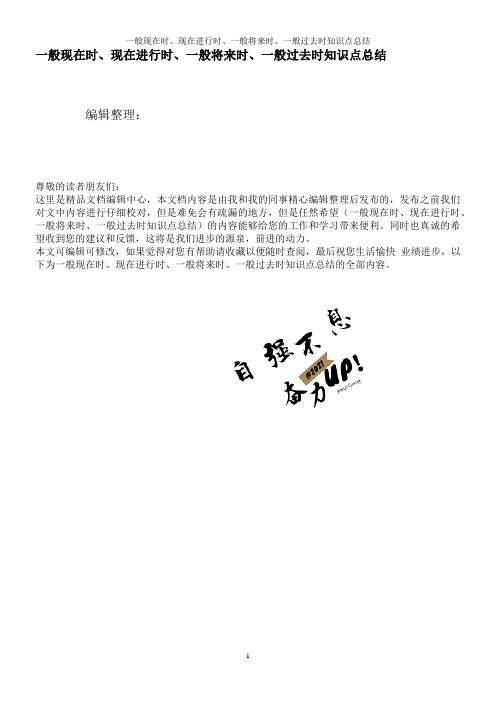
一般现在时、现在进行时、一般将来时、一般过去时知识点总结编辑整理:尊敬的读者朋友们:这里是精品文档编辑中心,本文档内容是由我和我的同事精心编辑整理后发布的,发布之前我们对文中内容进行仔细校对,但是难免会有疏漏的地方,但是任然希望(一般现在时、现在进行时、一般将来时、一般过去时知识点总结)的内容能够给您的工作和学习带来便利。
同时也真诚的希望收到您的建议和反馈,这将是我们进步的源泉,前进的动力。
本文可编辑可修改,如果觉得对您有帮助请收藏以便随时查阅,最后祝您生活愉快业绩进步,以下为一般现在时、现在进行时、一般将来时、一般过去时知识点总结的全部内容。
一般现在时、一般将来时、一般过去时、现在进行时知识总结一、一般现在时一般现在时表示经常性或习惯性的动作,常与表示频度的时间状语连用,如often, usually, always, sometimes, never, seldom, every week/day/year/month。
.。
, once a week, on Sundays等.动词用原形。
当主语为第三人称单数时(he, she, it, 一个人名) ,动词变第三人称单数的动词变化规则:(只有在第三人称(he, she, it, 一个人名)为主语的肯定句中,动词才用三单式)(1)一般情况下,直接加s runs gets likes(2)结尾是s, x, sh, ch, o,前为辅音字母,结尾加es watches, goes,washes, crosses, mixes, does(3)动词末尾y,前为辅音,将y改为i加es study→studies fly→flies 但在y前如果为元音则直接加s buys says plays(4)不规则变形 have—has二、一般将来时一般将来时表示将来发生的事。
常与tomorrow, nextday/week/month/year。
.。
, soon, in a few minutes, the dayafter tomorrow, in the future等时间状语连用。
一般现在时、现在进行时、一般将来时讲解

that you ries因为你所想都是坏的回忆 take your time, you'll find it.别着急,你会找到的
❖4.guess__________ watch__________
❖5.. go__________
do___________
❖6. study__________ fly__________
❖7.cry__________
play__________
❖8. have__________
一般现在时
I see your monsters,我看到你的野兽 I see your pain.你的痛苦
Tell me your problems,向我倾诉你的麻烦 I'll chase them away.我会把它们赶走 I'll be your lighthouse.我会是你的灯塔 I'll make it okay.我会保护你
❖6. study studies fly flies
❖7.cry cries
play plays
❖8. have has
一般现在时
结构2:主语+行为动词+其它 (但是当主语是第三人称单数时,行为动词+s/es/y改i加
es) We go to school at 7:00. Lucy goes to school at 7:00. She stduies English every day. 否定句结构:主语+don’t/doesn’t+动词原形+其它 We don’t go to school at 7:00. Lucy doesn’t go to school at 7:00. She doesn’t stduy English every day.
七个时态
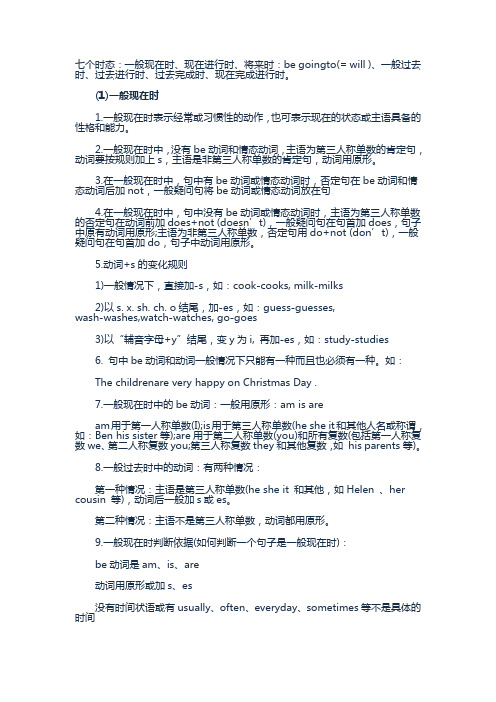
七个时态:一般现在时、现在进行时、将来时:be goingto(= will )、一般过去时、过去进行时、过去完成时、现在完成进行时。
(1)一般现在时1.一般现在时表示经常或习惯性的动作,也可表示现在的状态或主语具备的性格和能力。
2.一般现在时中,没有be动词和情态动词,主语为第三人称单数的肯定句,动词要按规则加上s,主语是非第三人称单数的肯定句,动词用原形。
3.在一般现在时中,句中有be动词或情态动词时,否定句在be动词和情态动词后加not,一般疑问句将be动词或情态动词放在句4.在一般现在时中,句中没有be动词或情态动词时,主语为第三人称单数的否定句在动词前加does+not (doesn’t),一般疑问句在句首加does,句子中原有动词用原形;主语为非第三人称单数,否定句用do+not (don’t),一般疑问句在句首加do,句子中动词用原形。
5.动词+s的变化规则1)一般情况下,直接加-s,如:cook-cooks, milk-milks2)以s. x. sh. ch. o结尾,加-es,如:guess-guesses,wash-washes,watch-watches, go-goes3)以“辅音字母+y”结尾,变y为i, 再加-es,如:study-studies6. 句中be动词和动词一般情况下只能有一种而且也必须有一种。
如:The childrenare very happy on Christmas Day .7.一般现在时中的be动词:一般用原形:am is aream用于第一人称单数(I);is用于第三人称单数(he she it和其他人名或称谓,如:Ben his sister等);are用于第二人称单数(you)和所有复数(包括第一人称复数we、第二人称复数you;第三人称复数they和其他复数,如his parents等)。
8.一般过去时中的动词:有两种情况:第一种情况:主语是第三人称单数(he she it 和其他,如Helen 、her cousin 等),动词后一般加s或es。
一般现在时,现在进行时和一般将来时的总结

3.—Can I use your dictionary?
—Sorry, I ___ using
D. would use
4.Don’t believe him. He ____.
A. told lies
B. is always telling lies
C. is about to tell lies D. is going to tell lies
5.A teacher as well as some of his
students____ trees in the garden now.
A. is planting B. are planting
C. plants
D. plant
6.Dr. Smith, together with her wife and
daughters,____ visit Beijing this summer.
A. is going to
B. are going to
实战演练 1. The teacher said that the earth
___round the sun in 365 days. A. move B. moved C. moves D. has
moved
2.I will go and make sure when the next train____.
注意:will+V和be going to +V在表示 将来时态可以互换,但是will+V倾向表 示临时决定将要做某事,be going to +V倾向表示经过考虑,安排将去做某事; 还可以表示将要发生的动作是有迹象表
一般现在时-一般过去时-一般将来时及现在进行时
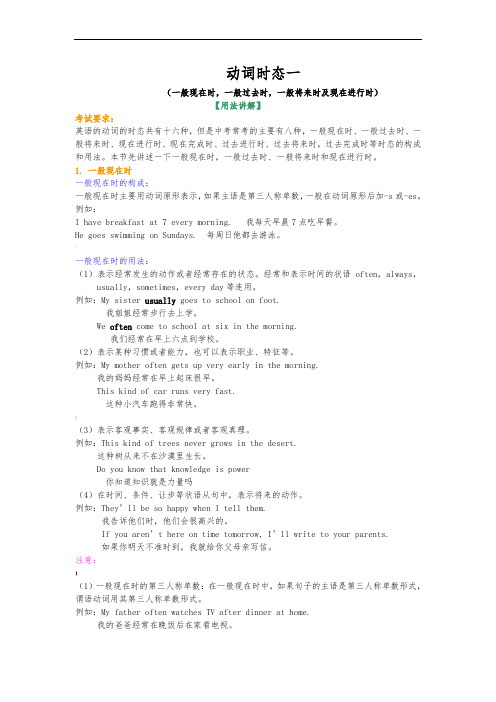
动词时态一(一般现在时,一般过去时,一般将来时及现在进行时)【用法讲解】考试要求:英语的动词的时态共有十六种,但是中考常考的主要有八种,一般现在时、一般过去时、一般将来时、现在进行时、现在完成时、过去进行时、过去将来时,过去完成时等时态的构成和用法。
本节先讲述一下一般现在时,一般过去时、一般将来时和现在进行时。
1. 一般现在时一般现在时的构成:一般现在时主要用动词原形表示,如果主语是第三人称单数,一般在动词原形后加-s或-es。
例如:I have breakfast at 7 every morning. 我每天早晨7点吃早餐。
He goes swimming on Sundays. 每周日他都去游泳。
^一般现在时的用法:(1)表示经常发生的动作或者经常存在的状态。
经常和表示时间的状语often,always,usually,sometimes,every day等连用。
例如:My sister usually goes to school on foot.我姐姐经常步行去上学。
We often come to school at six in the morning.我们经常在早上六点到学校。
(2)表示某种习惯或者能力,也可以表示职业、特征等。
例如:My mother often gets up very early in the morning.我的妈妈经常在早上起床很早。
This kind of car runs very fast.这种小汽车跑得非常快。
\(3)表示客观事实、客观规律或者客观真理。
例如:This kind of trees never grows in the desert.这种树从来不在沙漠里生长。
Do you know that knowledge is power你知道知识就是力量吗(4)在时间、条件、让步等状语从句中,表示将来的动作。
例如:They’ll be so happy when I tell them.我告诉他们时,他们会很高兴的。
一般现在时、一般过去时、一般将来时、现在进行时
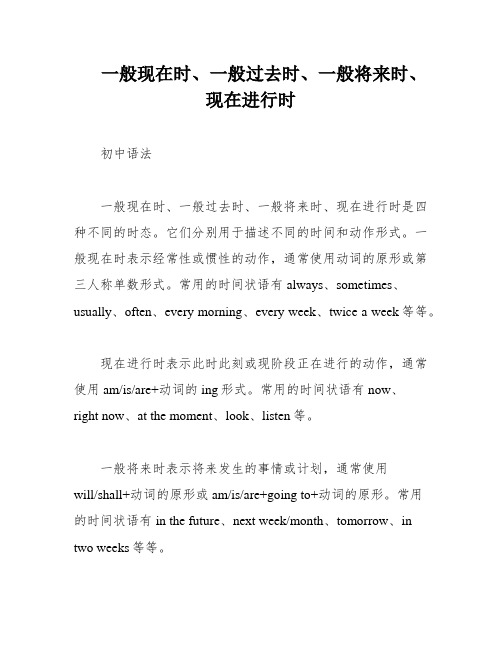
一般现在时、一般过去时、一般将来时、现在进行时初中语法一般现在时、一般过去时、一般将来时、现在进行时是四种不同的时态。
它们分别用于描述不同的时间和动作形式。
一般现在时表示经常性或惯性的动作,通常使用动词的原形或第三人称单数形式。
常用的时间状语有always、sometimes、usually、often、every morning、every week、twice a week等等。
现在进行时表示此时此刻或现阶段正在进行的动作,通常使用am/is/are+动词的ing形式。
常用的时间状语有now、right now、at the moment、look、listen等。
一般将来时表示将来发生的事情或计划,通常使用will/shall+动词的原形或am/is/are+going to+动词的原形。
常用的时间状语有in the future、next week/month、tomorrow、in two weeks等等。
一般过去时表示过去某一时刻或过去某一段时间所发生的动作,与现在无关。
动词的变化规则有以下几种:1)大多数动词在词尾加“S”;2)以辅音字母加“y”结尾的,要先将“y”变为“i”,然后在加“es”;3)以“s。
x。
ch。
sh”结尾的,在词尾加“es”;4)以“o”结尾的动词,加“es”。
现在进行时使用动词的ing形式,变化规则有以下几种:1)一般动词直接在词尾+ing;2)以不发音e结尾的动词,先去e再加ing;3)以重读闭音节结尾且末尾只有一个辅音字母的动词,双写末尾字母,再加ing。
3、一般过去时——动词的变化规则一般过去时是描述过去发生的事情,动词的变化规则如下:1)一般在动词后加-ed。
如:play-played。
offer-offered。
weigh-weighed。
destroy-destroyed。
sign-signed2)在以字母e结尾的动词后,只加-d。
如:like-liked。
- 1、下载文档前请自行甄别文档内容的完整性,平台不提供额外的编辑、内容补充、找答案等附加服务。
- 2、"仅部分预览"的文档,不可在线预览部分如存在完整性等问题,可反馈申请退款(可完整预览的文档不适用该条件!)。
- 3、如文档侵犯您的权益,请联系客服反馈,我们会尽快为您处理(人工客服工作时间:9:00-18:30)。
一般现在时含义:表示事物(或人)的特征、状态,或表示经常性或习惯性的动作。
在一般现在时中,当主语是第三人称单数时,谓语动词要用第三人称单数形式,即常在动词原形后加-s或-es。
注:常见的词有:always、usually、often、sometimes等频率副词。
第三人称单数形式构成规则:1、大多数动词在词尾加“S”如:read-reads2、以辅音字母加“y”结尾的,要先将“y”变为“i”,然后在加“es”;以元音字母加“y”结尾的,直接加“S” 如:fly-flies play-plays3、以“s, x, ch, sh”结尾的,在词尾加“es”如:watch-watches4、以“o”结尾的动词,加“es”,如:go-goes5、以不发音字母“e”结尾的开音节词,加“s” 如:make-makes6、特殊:be动词包括:am,is,are第三人称单数为ishave -has三、写出下列动词的第三人称单数形式:visit--guess--take--go--rush--feel--cook--wash--fly--be--say--run--do--worry--live--watch--enjoy--have--like--play--use--teach--buy--study--四、用括号内动词的适当形式填空。
1. She often __________ (have)lunch at home.2. Sarah and Tom __________ (be) in Class One.3. We__________ (not watch) TV on Monday.4. Oliver __________ (not go) to school on Sunday.5.__________ they __________ (like)playing football?6. What __________ they often__________ (do) on Saturdays?7. __________ your parents __________ (read) newspapers?8. The girl__________ (teach) us English on Sundays.9. She and I __________ (take) a walk together every evening.10. There __________ (be) some water in the bottle.11. Mike__________ (like) cooking.12. He__________ (have) two new books.13. My sister __________ (look) after her baby carefully.14. You always __________ (do) your homework well.15. I__________ (be) ill. I’m staying in bed.16. She __________ (go) to school from Monday to Friday.17. Liu Tao __________ (do) not like PE.18. The child often __________ (watch) TV in the evening.19. -What day __________(be) it today?-It’s Saturday-How__________Dad __________(feel)?-He __________(feel) not well.-Where__________ he __________(work)?-He __________(work) at sea.现在进行时含义:表示正在做某事。
注:常见的词有:now现在、look看、listen听等。
现在进行时的构成:am/is/ are+ v-ing是现在进行时的构成形式v-ing现在分词的构成:总结小学阶段需要双写最后一个字母再加ing的现在分词:let put sit , stop shop , forget get , begin jog run swim(让我们放下来,坐下来,停止购物,忘记取得,开始跑跑跳跳)letting putting sitting stopping shopping forgetting getting beginning jogging running swimming写出下列动词的现在分词形式:visit--put--take--go--get--see--cook--wash--fly--let--say--swim--do--sit--live--watch--enjoy--have--run--play--use--teach--buy--study--三、用所给的动词的正确形式填空:1.The boy __________________ ( draw)a picture now.2. Listen .Some girls __________________( sing)in the classroom .3. My sister __________________ ( swim ) now.4. What __________ you__________( do ) now?5. Look . They __________________ ( have) an English lesson .6.They__________________ (not ,water) the flowers now.7.Look! The girls__________________ (dance )in the classroom .8.What is Tom doing? She __________________ (listen ) to music.9.It’s 5:00 now. I__________________ (run).10.Hear!The bird__________________(sing).一般将来时一:含义:表示将来计划、准备、打算做某事。
二:标志词:tonight今晚,tomorrow明天,the day after tomorrow后天,this morning/afternoon/evening今天早上/下午/晚上,next week/weekend/month/year下一周/下一周末/下个月/下年, in two years两年后, three days later三天以后等。
三:结构:will/shall+do(动词原形)(will可用于所有人称,shall只用于第一人称I 和we)be going to+do(动词原形)(be--am/is/are根据主语的变化而变化)四、练习:填空。
1. 我打算明天和朋友去野炊。
I_____ _______ _________ have a picnic with my friends.I ________ have a picnic with my friends.2. 下个星期一你打算去干嘛? 我想去打篮球。
What ________ ________ _________ _________ _________ next Monday?I _______ ______ _____ play basketball.What _________ you do next Monday? I ________ play basketball.3. 你妈妈这个周末去购物吗?是,她要去买一些水果。
_____ your mother _______ ________ go shopping this ___________? Yes, she _________.She ______ ________ __________ buy some fruit.4. 你们打算什么时候见面。
What time _______ you _________ __________ meet?五、改句子。
1、Tom is going to go camping.(改否定)→ Tom ________ going to go camping.2. I’ll go and join them.(改否定)→ I _______ go ______ join them.3. I’m going to get up at 6:30 tomorrow.(改为一般疑问句)→________ _______ ________ to get up at 6:30 tomorrow?We will meet at school at 10:30.(改为一般疑问句)→_______ ________ meet at the bus stop at 10:30.. She is going to listen to music after school.(对划线部分提问)→________ _______ she ________ ________ _________ after school?六:用所给词的适当形式填空。
Today is a sunny day. We ___________________ (have) a picnic this afternoon.2. My brother _______________ (go) to Shanghai next week.3. Tom often ______________(go) to school on foot. But today is rain. He _____ _________ (go) to school by bike.4. What do you usually do at weekends? I usually ________ (watch) TV.5. It’s Friday today. What _____she _________ (do) this weekend? She _______ ____(watch) TV .名词的复数形式1.一般情况下,直接加-s,如:book-books, bag-bags, cat-cats,house-houses2.以s. x. sh. ch结尾,加-es,如:bus-buses, box-boxes, watch-watches3.以“辅音字母+y”结尾,变y为i, 再加-es;以“元音字母+y”结尾,直接加-s 如:family-families, toy-toys4.以-o结尾,一般在词尾加-es.如:tomato-tomatoes,potato-potatoes5.以“f或fe”结尾,变f或fe为v, 再加-es,如:knife-knives,wife-wives等6.不规则名词复数:(1)特殊变换:man-men, woman-women, policeman-policemen, policewoman-policewomen, mouse-mice,child-children,foot-feet,.tooth-teeth(2)单复数同行:fish-fish, people-people, Chinese-Chinese,Japanese-Japanese sheep-sheep bread-bread等等。
